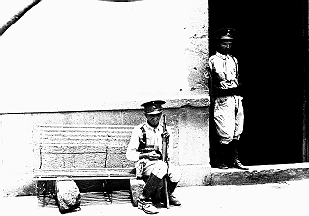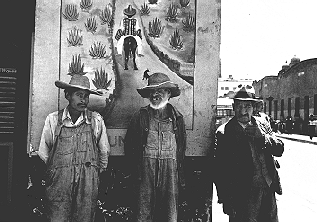Mexico City
James Oles

DoubleTake Books & Magazine publish the works of writers and photographers who seek to render the world as it is and as it might be, artists who recognize the power of narrative to communicate, reveal, and transform.
It comes out as a quarterly, with writing that is of the New Liberal- Notwithstanding all that, the photographs that appear in the magazine and in their books have merit --- especially when they publish black-&-whites from lesser-known masters of the past, like Helen Levitt. She went to Mexico City in 1941 (with, of all people, the wife of James Agee.) She obviously had been influenced by those who had photographed the poor in Mexico City before her (Tina Modotti, Anton Bruehl, Manuel Álvarez Bravo, Edward Weston), so she stayed away from the popular photographic arenas, instead went into the poorer colonias around the La Merced market, into Tacuba and Tacubaya, got people where they lived, not dolled up as the tourist bureau posters and postcards would want them. As in all of Mexico, especially fifty years ago, there is a music and a dance in even the poorest life (especially if we compare it with the sheer bleakness of the WPA photographs of the mountain people of Tennessee, the dust farms of Oklahoma), and Levitt catches the rhythms of arches and angles, shadows and intense brightness of that dry, hot, and --- in 1941 --- hideously poor country. There's the smell of Buñuel in what she puts together: one can see here the characters who created Los Olvidados. There, too, is the language --- although Levitt did not speak Spanish, she was sure to include parts of signs, large and small, which gives a pithy commentary to whatever visuals she is laying out for us. For instance, there's a tiny lettering on the basket of a wretched bicycle, soy biudo busco novia... which is a simple plain (sad) advertisement --- misspelled --- for a girlfriend: "I am a widower; I'm looking for a sweetheart." It is said once that when the BBC went into Calcutta to film a program about poverty --- the cameramen and director were stoned by the citizens. The people were poor, obviously, but they damn well didn't want folks with $100,000 worth of equipment coming into their world, exploiting them...exploiting them, that is, even more than they were. That was why, no doubt, Levitt used a camera that had a 90° lens so she could take photographs that would allow her to pretend she was shooting straight ahead, when the business-end of the camera was pointed at the action. In addition, she had the advantage, in that macho world, of being a gringa. All well-dressed white-skinned ladies walking alone in those neighborhoods were whores --- unless they had a camera; then they were tourists. No Mexican, male or female, would take her seriously. This gave Levitt a singular advantage of being able to being able to go where others might not have been able to move anonymously. In these bleak black-and-white shadowed photographs, it's impossible not to smell the streets, the dogs, the dog-piss, the sewage, the unwashed, and ragged, and dirty children, the drunken men. But Levitt is not a do-gooder per se. She was an artist, more concerned about marrying the arches, the cracks in the wall, the fallen plaster, the shadows --- to the humans. Her most famous photograph, often reproduced, is of two boys wrestling on their backs in the courtyard of the convent of La Merced. The arches are reflected in the entangled limbs of the boys. Form follows function. Agave plants figure strongly here, not only because of the these plants insinuate themselves everywhere in the desert world of Central and Northern Mexico; they also intrude on the lives of the poor: from the agave, distillers create the psychedelic alcohol buzz juice favored by them. The traditional way for a poor Mexican (then as now) to forget the harsh, hot world was in the pulquerías. (Then as now, foreigners take their lives in their hands when they venture alone in the cantinas.) Having said all these wonderful things about this book --- and it is wonderful with its fine photographs (over a hundred of them), astute commentary (both in English and in Spanish) --- we should point out that it is typical that DoubleTake chose for the cover of Helen Levitt: Mexico City as well as a recent issue of the magazine one of the few photographs she produced designed not to frighten the gentry --- showing a pleasant, obviously poor Mexican couple, against a torn wall; he in his coveralls, holding her hand, obviously telling a whopper; and she, hands on hips, looking as if she's heard the story many times before, ready to bolt out of the picture and down the hill when he moves in for the kill (a loan? a free lunch? a night in the sack?) It's an neat picture --- but it's tame, especially for Levitt. She saw her job as rendered the world of Mexico City as it was. It was interesting, but it sure as hell wasn't droll.
 Levitt, Tina Modotti, and Edward Weston delighted in the wall-paintings that were signs for the pulquerías --- the places where the poorest of the men could, for a few centavos, have a cup or two of pulque --- that fire-breathing liquor taken from the cactus. (One critic said that with the paintings that decorated the walls of these cantinas, going through the streets of Mexico City was like going through a very colorful art gallery.)
Levitt, Tina Modotti, and Edward Weston delighted in the wall-paintings that were signs for the pulquerías --- the places where the poorest of the men could, for a few centavos, have a cup or two of pulque --- that fire-breathing liquor taken from the cactus. (One critic said that with the paintings that decorated the walls of these cantinas, going through the streets of Mexico City was like going through a very colorful art gallery.)